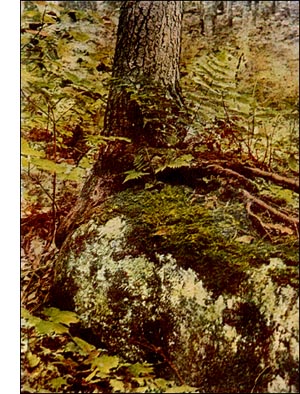Whip Fork Moss
 Whip Fork-Moss, Dicranum flagellare, Hedw.
Whip Fork-Moss, Dicranum flagellare, Hedw.Habit and habitat.-Growing in bright green, dense tufts producing fragile, small-leaved branches (flagellae) in the axils of the upper leaves. Common on decayed trunks in deep woods.
Name.-The specific name flagellum, the Latin for "whip," refers to the young branches, which are so small as to be easily overlooked. They fall away as the plant dries.
Plant (gametophyte).-Repeatedly branching ; stems 1 to 2 inches high ; covered with a thick felt of hairs.
Leaves.-Forming little clusters on the summits of the stems ; lance-shaped, convolute ; apex toothed, turned back from the stem, the upper twisted when dry ; margin below entire, incurved ; vein broad, compressed, extending to the apex ; cells inflated at the basal angles, yellow-brown, four-sided. The leaves of the " whips " have no vein.
Leaves at the base of the pedicel (perichaetial leaves).-Rolled about the pedicel.
Habit of flowering.-Male and female flowers on separate plants (dioicous).
Veil (calyptra).-Split on one side.
Spore-case.-Erect symmetrical, long, cylindrical, grouped lengthwise when dry.
Pedicel (seta).-Pale, twisted to the left when dry.
Lid (operculum).-Conical, with long oblique beak.
Annulus.-Narrow.
Teeth ( peristome).-Sixteen, narrow, cleft nearly to the base.
Spores.-Mature in autumn.
Distribution.-North America, Asia, Africa ; rare in Great Britain.